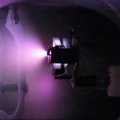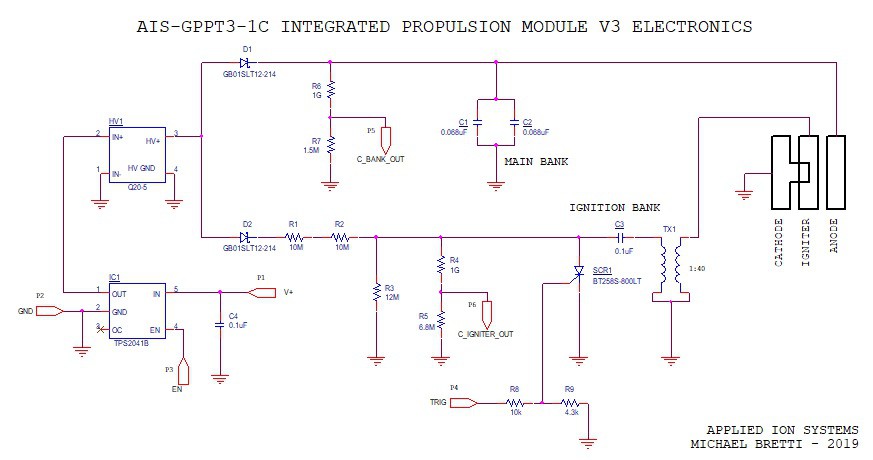-
Hack Chat Transcript, Part 2
12/11/2019 at 21:19 • 0 comments![]() However, for plasma thruster testing, 10^-5 is more than fine, and where I start operating at. technically, 10^-4 is the bare recommended rule of thumb min for plasma thrusters, but you want at least a decade overhead in your pumping requirements
However, for plasma thruster testing, 10^-5 is more than fine, and where I start operating at. technically, 10^-4 is the bare recommended rule of thumb min for plasma thrusters, but you want at least a decade overhead in your pumping requirements![]() If you can do local pickup, sometimes entire SEMs that include vacuum chamber, pumps, and controllers is cheaper than buying them seperately
If you can do local pickup, sometimes entire SEMs that include vacuum chamber, pumps, and controllers is cheaper than buying them seperately![]() Actually, my vacuum system is very simple compared to a lot of other enthusiasts out there
Actually, my vacuum system is very simple compared to a lot of other enthusiasts out there![]() I assumed the vac test videos I saw were at a facility designed for that kind of thing. Very cool. Is your background specifically in astro thrusters?
I assumed the vac test videos I saw were at a facility designed for that kind of thing. Very cool. Is your background specifically in astro thrusters?![]() i just joined, sorry if this was covered, i heard for some very high vacuum stuff, you bake the chamber to remove gases that 'stick' to the sides iirc, do you do anything like that?
i just joined, sorry if this was covered, i heard for some very high vacuum stuff, you bake the chamber to remove gases that 'stick' to the sides iirc, do you do anything like that?![]() SEMs are great, however not really ideal for a thruster chamber. You could get a simple one much cheaper. Mine is based off of only 2 6" conflat tees. It shows that you can do this testing with an incredibly small system, as opposed to the often massive chambers you seen that you can walk into that most places have
SEMs are great, however not really ideal for a thruster chamber. You could get a simple one much cheaper. Mine is based off of only 2 6" conflat tees. It shows that you can do this testing with an incredibly small system, as opposed to the often massive chambers you seen that you can walk into that most places have![]() @Bob nope, no formal background in any thruster stuff. However, I have come to study and specialize in areas such as plasma, pulsed power, high voltage, particle beams, and high vacuum on my own, which all comes together for this stuff
@Bob nope, no formal background in any thruster stuff. However, I have come to study and specialize in areas such as plasma, pulsed power, high voltage, particle beams, and high vacuum on my own, which all comes together for this stuff![]() @anfractuosity actually, i don't need to bake for my system. Pumping speed is so high for the small chamber, and I don't need to reach UHV that it's not really necessary. Only really need to bake if trying to break past the 10^-7 and higher range
@anfractuosity actually, i don't need to bake for my system. Pumping speed is so high for the small chamber, and I don't need to reach UHV that it's not really necessary. Only really need to bake if trying to break past the 10^-7 and higher range![]() Encouraging stuff. I'm working my way towards an astronautical engineering path, kind of picking your experience for tips to get my feet wet before I reach that part of my education :)
Encouraging stuff. I'm working my way towards an astronautical engineering path, kind of picking your experience for tips to get my feet wet before I reach that part of my education :)![]() aha, gotcha, thanks!
aha, gotcha, thanks!![]() But yes, baking is used to desorb the gasses, and is definitely needed for most UHV applications
But yes, baking is used to desorb the gasses, and is definitely needed for most UHV applications![]() Are vacuum chambers needed to test the thrusters? Because once you have launched the satellite into space there won't be any need of vacuum chambers.
Are vacuum chambers needed to test the thrusters? Because once you have launched the satellite into space there won't be any need of vacuum chambers.![]() @yashelite Yes, vacuum is needed for ground testing. You need to be able to generate high vacuum at the ground level. Once in space, it is already in vacuum. These thrusters just won't work at atmosphere
@yashelite Yes, vacuum is needed for ground testing. You need to be able to generate high vacuum at the ground level. Once in space, it is already in vacuum. These thrusters just won't work at atmosphere![]() Actually, I precheck the PPTs in atmosphere by firing the igniter and listening for the spark "click" sound. Since it is not in vacuum, the main bank can't fire. It allows me to check HV and ignition circuitry, then I test ignition at high vacuum after everything is verified
Actually, I precheck the PPTs in atmosphere by firing the igniter and listening for the spark "click" sound. Since it is not in vacuum, the main bank can't fire. It allows me to check HV and ignition circuitry, then I test ignition at high vacuum after everything is verified![]() for ILIS though everything must be tested at high vacuum.
for ILIS though everything must be tested at high vacuum.![]() Spark plug thrusters and EMC. How to be able to have circuitry next to it?
Spark plug thrusters and EMC. How to be able to have circuitry next to it?![]() hi and thanks for the chat with us.
hi and thanks for the chat with us.how about power during the orbit cubesat mission. how much power does the system need and is it more like charging it for a long time and then bursting it out in a short period of thrust?
![]() @Jonny Wester well, that can be a challenge. The PPT at least can crash the arduino which poses some testing issues for sure. For onboard testing, that is one thing that will be checked with qualifications with the GENESIS mission, to see if it interferes with the computer and if shielding is required. Usually for PPTs, some form of EMF shielding is needed
@Jonny Wester well, that can be a challenge. The PPT at least can crash the arduino which poses some testing issues for sure. For onboard testing, that is one thing that will be checked with qualifications with the GENESIS mission, to see if it interferes with the computer and if shielding is required. Usually for PPTs, some form of EMF shielding is needed![]() @Applied Ion Systems I am checking on the current status of nuclear propulsion. I have been tracking develoments for nearly 50 years. Your immediate reaction reflects the poor state of developments and poor options currently available. I know of some alternatives but they are not cost effective for anything less that a few hundred kilowatts. And they are not radioactive but use inner bond energies that are intermediate between the 0-10 eV per bond of chemicals and the roughly 2 MeV per bond of "nuclear". I call these "intermediate" or "atomic" energy reactions. They range from 10 eV per bond up to 2 MeV per bond. They will not work in plasma, but only very very precise atomic beams. There are many electron reactions that are good candidates for intermediate storage. Several of the aneutronic fusion reactions are members of this much larger class of intermediate energy reactions. They are actually fairly easy to model since they use classical quantum mechanics and electrodynamics. And the reactions are essentially independent events.
@Applied Ion Systems I am checking on the current status of nuclear propulsion. I have been tracking develoments for nearly 50 years. Your immediate reaction reflects the poor state of developments and poor options currently available. I know of some alternatives but they are not cost effective for anything less that a few hundred kilowatts. And they are not radioactive but use inner bond energies that are intermediate between the 0-10 eV per bond of chemicals and the roughly 2 MeV per bond of "nuclear". I call these "intermediate" or "atomic" energy reactions. They range from 10 eV per bond up to 2 MeV per bond. They will not work in plasma, but only very very precise atomic beams. There are many electron reactions that are good candidates for intermediate storage. Several of the aneutronic fusion reactions are members of this much larger class of intermediate energy reactions. They are actually fairly easy to model since they use classical quantum mechanics and electrodynamics. And the reactions are essentially independent events.![]() @hornig that is the big question. Ultimate performance capabilities of EP is first and foremost limited by onboard power. For a 1P PQ, I have maybe a few hundred mW to play with. While the PPT I designed for them will fire, it just cannot provide useful thrust at that power input - the scaling for this tech doesn't work out. Switching to ILIS, at the 1.5W power level, it can provide significant thrust, enough for station keeping and orbital manuevers. this would be suited for a well equipped 2P or 3P PQ, and getting into the small Cubesat range easily
@hornig that is the big question. Ultimate performance capabilities of EP is first and foremost limited by onboard power. For a 1P PQ, I have maybe a few hundred mW to play with. While the PPT I designed for them will fire, it just cannot provide useful thrust at that power input - the scaling for this tech doesn't work out. Switching to ILIS, at the 1.5W power level, it can provide significant thrust, enough for station keeping and orbital manuevers. this would be suited for a well equipped 2P or 3P PQ, and getting into the small Cubesat range easily![]() We have trouble with controlling an anchor system, so I can imagine. And a plain Arduino! Amazing...tin foil will not be enough. Opto isolation and really thought out shielding would be needed.
We have trouble with controlling an anchor system, so I can imagine. And a plain Arduino! Amazing...tin foil will not be enough. Opto isolation and really thought out shielding would be needed.![]() We're an hour into the chat now, so we have to let Michael get back to work if he needs to. Everyone is welcome to stay on the chat is they have time, of course. I want to thank Michael for tolerating several reschedulings to finally be with us today. I really enjoyed this chat, learned a lot. Thanks Michael!
We're an hour into the chat now, so we have to let Michael get back to work if he needs to. Everyone is welcome to stay on the chat is they have time, of course. I want to thank Michael for tolerating several reschedulings to finally be with us today. I really enjoyed this chat, learned a lot. Thanks Michael!![]() Or soft sparking...!
Or soft sparking...!![]() Thanks for being here, Michael. Fascinating project and results -- good luck in the future!
Thanks for being here, Michael. Fascinating project and results -- good luck in the future!![]() And next week we'll be switching gears entirely for the last Hack Chat of 2019. We'll have Shahriar from The Signal Path on to talk about the weird world of microwave electronics:
And next week we'll be switching gears entirely for the last Hack Chat of 2019. We'll have Shahriar from The Signal Path on to talk about the weird world of microwave electronics:![]()
https://hackaday.io/event/167683-weird-world-of-microwaves-hack-chat
Weird World of Microwaves Hack Chat
Shahriar Shahramian joins us for the Hack Chat on Wednesday, December 18, 2019 at noon PST. Time zones got you down? Here's a handy time converter! Shahriar is no stranger to this land. He's been studying millimeter-wave systems for decades, and his day job is researching millimeter-wave ASICs for Nokia Bell Labs in New Jersey.
![]() @Dan Maloney thanks for the awesome opportunity to chat! I am actually free for a while to continue if anyone would like to chat more
@Dan Maloney thanks for the awesome opportunity to chat! I am actually free for a while to continue if anyone would like to chat more![]() You bet. I'll wait a while to pull the transcript then, so we capture all the details. Thanks!
You bet. I'll wait a while to pull the transcript then, so we capture all the details. Thanks!![]() I can't see the electronics work nearby the thousands of amps being switched next to it. We have a problem already at 100A....
I can't see the electronics work nearby the thousands of amps being switched next to it. We have a problem already at 100A....![]() Thanks for that, a glimpse into the world of a true pioneer. :-D
Thanks for that, a glimpse into the world of a true pioneer. :-D![]() Thanks for everything, It was great listening in
Thanks for everything, It was great listening in![]() @Applied Ion Systems no worries :). it is all about the strategie of how you do your demonstration run. I do space for a living and having a small well defined test is always another step into the right direction. even if you are charging the PQ batteries for some orbits and the use this for your tests, it will be usefull to know if you can get your system running and get you a higher TRL (tech readiness level). I would like to se you moving the pq into another orbit over a long time. (I do sat tracking) :)
@Applied Ion Systems no worries :). it is all about the strategie of how you do your demonstration run. I do space for a living and having a small well defined test is always another step into the right direction. even if you are charging the PQ batteries for some orbits and the use this for your tests, it will be usefull to know if you can get your system running and get you a higher TRL (tech readiness level). I would like to se you moving the pq into another orbit over a long time. (I do sat tracking) :)![]() @Jonny Wester it's actually not that much of an issue. Very fast pulses require simple shielding more than anything else
@Jonny Wester it's actually not that much of an issue. Very fast pulses require simple shielding more than anything else![]() @Morning.Star and @Nicolas Tremblay thanks!
@Morning.Star and @Nicolas Tremblay thanks!![]() Thank you, I came in very late, not easy from . Nano satellites, a real eye opener!
Thank you, I came in very late, not easy from . Nano satellites, a real eye opener!![]() Thank you Shahriar! You opened my eye!
Thank you Shahriar! You opened my eye!![]() @hornig that's the goal moving forward for the ILIS thruster stge of development. The PPT I built will up its TRL in space hopefully soon, but isn't useful as more than a demo payload and learning tool. the ILIS stuff will have real potential for PQ orbit maintanence and manuevers. One of the big things that is not well known are the thrst levels needed for a PQ. No one has actually modeled it in literature - really only at the Cubesat level, since propulsion for PQs isn't there yet - kind of jumping the market on this one!
@hornig that's the goal moving forward for the ILIS thruster stge of development. The PPT I built will up its TRL in space hopefully soon, but isn't useful as more than a demo payload and learning tool. the ILIS stuff will have real potential for PQ orbit maintanence and manuevers. One of the big things that is not well known are the thrst levels needed for a PQ. No one has actually modeled it in literature - really only at the Cubesat level, since propulsion for PQs isn't there yet - kind of jumping the market on this one!![]() @Jonny Wester thanks, glad you learned some from this chat!
@Jonny Wester thanks, glad you learned some from this chat!![]() What an fantastic opportunity to learn! Thanks for the chat!
What an fantastic opportunity to learn! Thanks for the chat!![]() Really nice chat. Regards
Really nice chat. Regards![]() @yashelite and @sfrias1 thanks, glad you enjoyed it! And you can be sure there is a lot more to come, this is really only the beginning of open source propulsion!
@yashelite and @sfrias1 thanks, glad you enjoyed it! And you can be sure there is a lot more to come, this is really only the beginning of open source propulsion!![]() friends at https://www.thrustme.fr/ and some others will try out propulsion on cubesats, so it is really interesting for the community out there.
friends at https://www.thrustme.fr/ and some others will try out propulsion on cubesats, so it is really interesting for the community out there.![]() but as you said, it won't be open-source(d)
but as you said, it won't be open-source(d)![]() @hornig yeah, lots of micro propulsion start ups out there aiming for cubesat test missions soon, but none are open source
@hornig yeah, lots of micro propulsion start ups out there aiming for cubesat test missions soon, but none are open source![]() other key players in this space include Morpheus Space, Enpulsion, Accion Systems, and Exotrail
other key players in this space include Morpheus Space, Enpulsion, Accion Systems, and Exotrail -
Hack Chat Transcript, Part 1
12/11/2019 at 21:18 • 0 comments![]() Hi everyone, welcome to the Hack Chat. Today we're excited to welcome Michael Bretti of Applied Ion Systems to the Hack Chat. He's literally building the future - open-source thrusters for DIY satellites that you'll be able to buy off-the-shelf someday!
Hi everyone, welcome to the Hack Chat. Today we're excited to welcome Michael Bretti of Applied Ion Systems to the Hack Chat. He's literally building the future - open-source thrusters for DIY satellites that you'll be able to buy off-the-shelf someday! Welcome Michael - can you tell us a little about how you got to this point?
![]() Thanks Dan! Like Dan mentioned, I am currently leading development of open source propulsion for small satellites. As far as I am aware, this is really the first and only fully open source propulsion program out there. I have a small, modular high vacuum system for testing these systems. Details are archived on my website here: http://appliedionsystems.com/
Thanks Dan! Like Dan mentioned, I am currently leading development of open source propulsion for small satellites. As far as I am aware, this is really the first and only fully open source propulsion program out there. I have a small, modular high vacuum system for testing these systems. Details are archived on my website here: http://appliedionsystems.com/![]() Other media and references can be seen on twitter and Instagram as well: https://twitter.com/Applied_Ion
Other media and references can be seen on twitter and Instagram as well: https://twitter.com/Applied_Ion![]()
https://www.instagram.com/appliedionsystems/
Login * Instagram
Welcome back to Instagram. Sign in to check out what your friends, family & interests have been capturing & sharing around the world.
![]() Currently, I have 2 thrusters slated for space this upcoming year with AMSAT-Spain's GENESIS PocketQubes
Currently, I have 2 thrusters slated for space this upcoming year with AMSAT-Spain's GENESIS PocketQubes![]() Lot's of new and exciting collaborations to come with others in the community though!
Lot's of new and exciting collaborations to come with others in the community though!![]() I was just going to ask when you expect to fly hardware. That's really exciting!
I was just going to ask when you expect to fly hardware. That's really exciting!![]() I have primarily been focusing on pulsed plasma thrusters, but have recently switched gears for more advanced systems such as ionic liquid ion source (ILIS) thrusters
I have primarily been focusing on pulsed plasma thrusters, but have recently switched gears for more advanced systems such as ionic liquid ion source (ILIS) thrusters![]() Yeah, it should be sometime early 2020, assuming they pass integration and environmental testing
Yeah, it should be sometime early 2020, assuming they pass integration and environmental testing![]() What is the primary power source?
What is the primary power source?![]() For the PPT that is being launched, the AIS-gPPT3-1C, it is designed to run from 3.3V to 4V power from the PQ battery bus
For the PPT that is being launched, the AIS-gPPT3-1C, it is designed to run from 3.3V to 4V power from the PQ battery bus![]() the circuit boosts this to about 1kV for the primary bank, and a pulse transformer provides a 10kv trigger pulse for ignition
the circuit boosts this to about 1kV for the primary bank, and a pulse transformer provides a 10kv trigger pulse for ignition![]() Ill post the circuit here
Ill post the circuit here![]() Solar panels feeding the batteries?
Solar panels feeding the batteries?![]()
![]()
![]() Yeah
Yeah![]() Can private groups use radio-isotopes yet?
Can private groups use radio-isotopes yet?![]() I highly doubt it, dealing with any radioactive sources would be a nightmare to deal with
I highly doubt it, dealing with any radioactive sources would be a nightmare to deal with![]() No need though, the groups out there are using quite high efficiency cells, and lots of exciting development for deployable arrays to really boost power capabiities
No need though, the groups out there are using quite high efficiency cells, and lots of exciting development for deployable arrays to really boost power capabiities![]() What type of fuel are you looking to use with the ILIS engine?
What type of fuel are you looking to use with the ILIS engine?![]() Plus I think the government has a pretty tight lid on plutonium-238 supply. They've got pretty much the world supply sitting in the RTGs that will go to Mars with the Mars Rover mission.
Plus I think the government has a pretty tight lid on plutonium-238 supply. They've got pretty much the world supply sitting in the RTGs that will go to Mars with the Mars Rover mission.![]() I will be using standard EMI-BF4, a popular room temperature ionic molten salt. Very well studied and understood, and highly stable
I will be using standard EMI-BF4, a popular room temperature ionic molten salt. Very well studied and understood, and highly stable![]() Pardon me for interrupting. What kinds of packages are people talking about sending?
Pardon me for interrupting. What kinds of packages are people talking about sending?![]() Weren't plasma thrusters first used in 1964? What kind of innovation or improvement has this now?
Weren't plasma thrusters first used in 1964? What kind of innovation or improvement has this now?![]() Electric propulsion (EP) in general dates back to the 60s. The thrusters built back then were monstrous though, huge beasts 10s to 100s of kW of power. The key difficulty in EP has been scaling down.
Electric propulsion (EP) in general dates back to the 60s. The thrusters built back then were monstrous though, huge beasts 10s to 100s of kW of power. The key difficulty in EP has been scaling down.![]() Curently, there is no EP solution on the market for PQs
Curently, there is no EP solution on the market for PQs![]() there is a lot of competition at the cubesat level, but it is still very costly
there is a lot of competition at the cubesat level, but it is still very costly![]() My goal is to radically bring down price, and scale to a level that is very accessible to low funded groups, as well as provide resources on these thrusters showing how I go through designing and building them, from concept to deployable solution
My goal is to radically bring down price, and scale to a level that is very accessible to low funded groups, as well as provide resources on these thrusters showing how I go through designing and building them, from concept to deployable solution![]() Cool
Cool![]() EP right now is highly protected, open source EP is unheard of in industry
EP right now is highly protected, open source EP is unheard of in industry![]() lots of details in academia, but published data or experiments is not quite the same as open source
lots of details in academia, but published data or experiments is not quite the same as open source![]() Have you gotten any pushback from the industry for disrupting things?
Have you gotten any pushback from the industry for disrupting things?![]() and most of it is just experimental benchtop systems
and most of it is just experimental benchtop systems![]() How far along are you with the ILIS thruster?
How far along are you with the ILIS thruster?![]() No not yet! But I am sure once i get the ILIS thruster running, I may make some enemies
No not yet! But I am sure once i get the ILIS thruster running, I may make some enemies![]() I have the design just about ready to go for first prototypes, just waiting on machining quote for the porous glass emitter
I have the design just about ready to go for first prototypes, just waiting on machining quote for the porous glass emitter![]() hopefully I'll have that quote today or tomorrow, which is the key driving cost for this thruster at this point
hopefully I'll have that quote today or tomorrow, which is the key driving cost for this thruster at this point![]() Be sure to patent your work.
Be sure to patent your work.![]() since it relies on standard CNC vs traditional micromachining, it allows ILIS thrusters to actually be accessible at this level
since it relies on standard CNC vs traditional micromachining, it allows ILIS thrusters to actually be accessible at this level![]() I've heard everyone saying to patent stuff
I've heard everyone saying to patent stuff![]() cant afford patents lol
cant afford patents lol![]() You seem to have devoted a lot of resources to the solid-fuel thrusters. Why the switch to liquid fuel?
You seem to have devoted a lot of resources to the solid-fuel thrusters. Why the switch to liquid fuel?![]() It will cost you dude.
It will cost you dude.![]() my budget is practiclly non-existant
my budget is practiclly non-existant![]() Patents are just permission slips to be sued.
Patents are just permission slips to be sued.![]() That's a nice way of putting it.
That's a nice way of putting it.![]() You can always start a Gofundme campaign or use crowdfunding.
You can always start a Gofundme campaign or use crowdfunding.![]() While solid PPT thrusters are great leaning tools, the physics just don't allow it to scale for the thrust needed at the power restrictions of a PQ. Hpwever, ILIS has extraordinary potential, in that it can provide very high thrust to power ratios at very high efficiency and ISP. This type of thruster also eliminates the need for any pressurized feed, valves, active flow control, heaters, or electron emitting neutralizer
While solid PPT thrusters are great leaning tools, the physics just don't allow it to scale for the thrust needed at the power restrictions of a PQ. Hpwever, ILIS has extraordinary potential, in that it can provide very high thrust to power ratios at very high efficiency and ISP. This type of thruster also eliminates the need for any pressurized feed, valves, active flow control, heaters, or electron emitting neutralizer![]() Yeah, but its the only protection you have. Licensing, especially public licensing isnt worth a damn. Just sayin lol.
Yeah, but its the only protection you have. Licensing, especially public licensing isnt worth a damn. Just sayin lol.![]() Hi! Excuse me. I am new in the topic. How many key pieces is a thruster comprised of?
Hi! Excuse me. I am new in the topic. How many key pieces is a thruster comprised of? Patents: If it is published anywhere, then it is not patentable anymore. Otherwise, you can afford $120 for the provisional that is good for a year, enough time to get some funding for the whole thing including patents. But then it is not open source anymore ^^
![]() Now THAT'S a Kickstarter I could back!
Now THAT'S a Kickstarter I could back!![]() Ditto
Ditto![]() @toani it depends on the thruster and the scale, it's hard to say unless we are talking about a specific system
@toani it depends on the thruster and the scale, it's hard to say unless we are talking about a specific system![]() hello
hello![]() from what I have seen full tech patents in the US can average around $20k
from what I have seen full tech patents in the US can average around $20k![]() I see thanks
I see thanks![]() Patent == patent attornies == billable hours
Patent == patent attornies == billable hours![]() As an individual doing this out of pocket in my free time, patents are out of the question
As an individual doing this out of pocket in my free time, patents are out of the question![]() Business is business.
Business is business.Anyway, rocket science ;-)
![]() Can the ILIS thrusters be used in heavy spaceships? Like say Falcon 9 which uses liquid oxygen as its primary fuel?
Can the ILIS thrusters be used in heavy spaceships? Like say Falcon 9 which uses liquid oxygen as its primary fuel?![]() but I will say that doing this type of work at a highly restricted budget has pushed me to think way outside the box and really simplify these systems
but I will say that doing this type of work at a highly restricted budget has pushed me to think way outside the box and really simplify these systems![]() @yashelite how do you define heavy?
@yashelite how do you define heavy?![]() I would continue with the open source and publish it at a few places to make sure your rights are recognized
I would continue with the open source and publish it at a few places to make sure your rights are recognized![]() like very large satellites?
like very large satellites?![]() Have you done any RF and optical evaluation yet? These types of electric propulsion systems are effectively spark gap transmitters that emit damped radio waves (bad) as well as ultra-violet emissions which can interfere with ground-based astronomical observations. To my knowledge these have only flown with experimental designation where these concerns could be coordinated accordingly.
Have you done any RF and optical evaluation yet? These types of electric propulsion systems are effectively spark gap transmitters that emit damped radio waves (bad) as well as ultra-violet emissions which can interfere with ground-based astronomical observations. To my knowledge these have only flown with experimental designation where these concerns could be coordinated accordingly.![]() @Nicolas Tremblay yeah, at this point I publish details and updates regularly on Twitter, and archive stuff on the website
@Nicolas Tremblay yeah, at this point I publish details and updates regularly on Twitter, and archive stuff on the website![]() By heavy I mean spaceships which can carry a substantial amount of payload.
By heavy I mean spaceships which can carry a substantial amount of payload.![]() @Ethan Waldo for ILIS no need - as a DC thruster it outputs no RF interference, and optically the emission is very light to negligeable. The PPTs can generate a bunch of noise due to the pulse, but they are the oldest and some of the most commonly flown and tested EP
@Ethan Waldo for ILIS no need - as a DC thruster it outputs no RF interference, and optically the emission is very light to negligeable. The PPTs can generate a bunch of noise due to the pulse, but they are the oldest and some of the most commonly flown and tested EP![]() PPTs especially due to their extreme simplicity, low cost, and ruggedness
PPTs especially due to their extreme simplicity, low cost, and ruggedness![]() Not the PPT, but the actual sparks between anode and cathode is what generates bad emissions
Not the PPT, but the actual sparks between anode and cathode is what generates bad emissions![]() @yashelite technically it could scale, but I think at a certain point the big ion or plasma engines would take over - efficiency and performance goes up with these at higher power levels, and ILIS is not at the point yet for massive array scaling
@yashelite technically it could scale, but I think at a certain point the big ion or plasma engines would take over - efficiency and performance goes up with these at higher power levels, and ILIS is not at the point yet for massive array scaling![]() Just like a spark plug
Just like a spark plug![]() @Ethan Waldo the PPT produces a spark - one for ignition, and the main plasma pulse. If the ILIS thruster sparks, then it can damage the thruster lol.
@Ethan Waldo the PPT produces a spark - one for ignition, and the main plasma pulse. If the ILIS thruster sparks, then it can damage the thruster lol.![]() So, orbital dynamics newbie here, maybe a dumb question. How do you get the thrust from one of these pointed in the right direction? IOW, how are PocketQubes able to control their attitude relative to the direction of orbit?
So, orbital dynamics newbie here, maybe a dumb question. How do you get the thrust from one of these pointed in the right direction? IOW, how are PocketQubes able to control their attitude relative to the direction of orbit?![]() The main discharge for a PPT can range from several hundreds to thousands of amps in a few uS
The main discharge for a PPT can range from several hundreds to thousands of amps in a few uS![]() @Dan Maloney great question! That's another task that needs to be addressed at the PQ level - attitude control. It's either you have none and tumble freely, have passive means like magnetorquers, or active control like reaction wheels
@Dan Maloney great question! That's another task that needs to be addressed at the PQ level - attitude control. It's either you have none and tumble freely, have passive means like magnetorquers, or active control like reaction wheels![]() yes, I would highly recommend an evaluation and publish results
yes, I would highly recommend an evaluation and publish results![]() Most PQs have some form of passive control
Most PQs have some form of passive control![]() active control is a challenge due to power and size constraints, but there are a few out there actively working on this
active control is a challenge due to power and size constraints, but there are a few out there actively working on this![]() I think I saw something about PQs having permanent magnets on board to keep them aligned to the earth's magnetic field. Is that magnetotorque?
I think I saw something about PQs having permanent magnets on board to keep them aligned to the earth's magnetic field. Is that magnetotorque?![]() Hi, Jonny from Sweden in China.
Hi, Jonny from Sweden in China. How do you switch a couple of thousands of Amps?
![]() So for the GENESIS satellite, the plan will be firing when it is passively aligned in the correct direction. So a period of about 15 minutes every 90 minute orbit
So for the GENESIS satellite, the plan will be firing when it is passively aligned in the correct direction. So a period of about 15 minutes every 90 minute orbit![]() @Dan Maloney yes that's correct
@Dan Maloney yes that's correct![]() @Jonny Wester no need to switch that current. The trigger pulse is a low current, high voltage pulse that ablates an initial amount of fuel between the cathode and igniter. This inital ionized fuel then allows for a conducting path to be formed between the anode and cathode, which a larger cap bank is charged and connected to. This energy gets directly dumped in, ablating more fuel, ionizing, and accelerating it as the plasma you see out the end.
@Jonny Wester no need to switch that current. The trigger pulse is a low current, high voltage pulse that ablates an initial amount of fuel between the cathode and igniter. This inital ionized fuel then allows for a conducting path to be formed between the anode and cathode, which a larger cap bank is charged and connected to. This energy gets directly dumped in, ablating more fuel, ionizing, and accelerating it as the plasma you see out the end.![]() So it acts essentially as a triggered spark gap switch
So it acts essentially as a triggered spark gap switch![]() albeit a bit different
albeit a bit different![]() (since triggered gaps don't rely on ablated ionized fuel for firing)
(since triggered gaps don't rely on ablated ionized fuel for firing)![]() and the plasma only works in a high enough vacuum :)
and the plasma only works in a high enough vacuum :)![]() here is a video of the thruster firing:
here is a video of the thruster firing:![]()
https://www.youtube.com/watch?v=sXPIOc-TzTk
![]() yeah, these thrusters require vacuum to operate correctly
yeah, these thrusters require vacuum to operate correctly![]() Capacitor banks, I have had dreams about this!!! Now they are real. So, creating plasma as a thruster.
Capacitor banks, I have had dreams about this!!! Now they are real. So, creating plasma as a thruster.![]() differnet types of thrusters have different types of vacuum testeing requirements
differnet types of thrusters have different types of vacuum testeing requirements![]() You might have to find several projects in development phase, then offer to design their propulsion subsytem. Ask for attitude data and methods for controlling orientation. If you can have multiple small units of yours - for each axis or primary direction, then you can write the control algorithms and model them.
You might have to find several projects in development phase, then offer to design their propulsion subsytem. Ask for attitude data and methods for controlling orientation. If you can have multiple small units of yours - for each axis or primary direction, then you can write the control algorithms and model them. The earliest plasma experiments were modified spark gaps where the ionization was provided by external sources - beta or alpha emitters, uv sources, electron beams, smaller ion and electron sources.
![]() Yeah, one of my main specialties, pulsed power, deals a lot with this in history. Dumping huge banks of energy into plasma or pulsed particle beam systems
Yeah, one of my main specialties, pulsed power, deals a lot with this in history. Dumping huge banks of energy into plasma or pulsed particle beam systems![]() Dates very early on back to the 50s
Dates very early on back to the 50s![]() Yes, massive pulsed capacitor banks, and "spark plugs", genious!
Yes, massive pulsed capacitor banks, and "spark plugs", genious!![]() That was the golden age of space exploration and propulsion systems.
That was the golden age of space exploration and propulsion systems.![]() @RichardCollins yeah, I'm actively collaborating with several groups
@RichardCollins yeah, I'm actively collaborating with several groups![]() Now there are supercapacitors.
Now there are supercapacitors.![]() Actually, spark gap switches are still to king of switching. Some of the state of the art stuff is really wild
Actually, spark gap switches are still to king of switching. Some of the state of the art stuff is really wild![]() at least in pulsed power they are a very dominant form of switching
at least in pulsed power they are a very dominant form of switching![]() What kind of facilities/equipment did it take to get to this stage? Have you done it all in your own shop / rented time / outsourced?
What kind of facilities/equipment did it take to get to this stage? Have you done it all in your own shop / rented time / outsourced?![]() It would interfere seriously with the electronics in the close vincinity controlling it. How to protect the control circuitry from thus massive EMC?
It would interfere seriously with the electronics in the close vincinity controlling it. How to protect the control circuitry from thus massive EMC?![]() @Bob the biggest requirement is high vacuum. This was all designed and optimied from scratch with available surplus. In the US at least, it is very easy to get vacuum equipemnt on ebay, however there is a whole group of vacuum enthusiasts around the world. if you are interested, I would check out the Vacuum Hackers discord chat. Fantastic place with tons of awesome high vacuum projects around the world. A lot of the design resources were free that I used - fusion 360 for CAD and thermal (CAD is a must for planning!), and a free vacuum simulation software from CERN called MOLFLOW+ (but this is highly overkill for most amaetur vacuum work). Really, it comes down to a lot of prep. I spent a year prior collecting resources, data, and getting preppped before designing my system so it would just work when switched on.
@Bob the biggest requirement is high vacuum. This was all designed and optimied from scratch with available surplus. In the US at least, it is very easy to get vacuum equipemnt on ebay, however there is a whole group of vacuum enthusiasts around the world. if you are interested, I would check out the Vacuum Hackers discord chat. Fantastic place with tons of awesome high vacuum projects around the world. A lot of the design resources were free that I used - fusion 360 for CAD and thermal (CAD is a must for planning!), and a free vacuum simulation software from CERN called MOLFLOW+ (but this is highly overkill for most amaetur vacuum work). Really, it comes down to a lot of prep. I spent a year prior collecting resources, data, and getting preppped before designing my system so it would just work when switched on.![]() For vacuum, I can reach in the 10^-6 torr range. I optimized my system for high pumping speed based off of 6" conflat hardware, which is pretty available, and not too bad in cost used, and is a good balance between size and cost for what I need
For vacuum, I can reach in the 10^-6 torr range. I optimized my system for high pumping speed based off of 6" conflat hardware, which is pretty available, and not too bad in cost used, and is a good balance between size and cost for what I need![]() That is really impressive! Helpful information, too. Thank you. I just spotted this project when it was featured on HaD but I'm pretty much glued to it now.
That is really impressive! Helpful information, too. Thank you. I just spotted this project when it was featured on HaD but I'm pretty much glued to it now.About Us Contact Hackaday.io Give Feedback Terms of Use Privacy Policy Hackaday API
 Lutetium
Lutetium






 We're an hour into the chat now, so we have to let Michael get back to work if he needs to. Everyone is welcome to stay on the chat is they have time, of course. I want to thank Michael for tolerating several reschedulings to finally be with us today. I really enjoyed this chat, learned a lot. Thanks Michael!
We're an hour into the chat now, so we have to let Michael get back to work if he needs to. Everyone is welcome to stay on the chat is they have time, of course. I want to thank Michael for tolerating several reschedulings to finally be with us today. I really enjoyed this chat, learned a lot. Thanks Michael!






